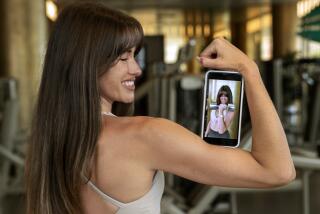Self-Image Can Prove Real Stretch for Non-Exercisers
- Share via
WASHINGTON — They need the exercise, but what keeps many people from starting can be summed up in a word: embarrassment.
They don’t join health clubs for fear their saggy, out-of-shape bodies will look out of place among the trim young athletes they expect to see there, researchers say. Ads featuring trim young athletes thus turn away a sizable segment of the population, the researchers say.
“It seems to be how you perceive yourself,” said Christine Brooks of the University of Michigan. “They are sure they couldn’t possibly do this.”
Sedentary people seem to begin with a perception of themselves and then measure it against their perception of the group, said Brooks, an associate professor of kinesiology.
Such people also do not respond to claims that they can make themselves better because they are focusing on how they are now, Brooks said.
Non-exercisers tend to see clubs as failing to pay attention to their problems, Brooks said.
“Where the embarrassment comes is, they see so many people lifting so much heavier weights,” Brooks said. “That makes them feel quite incompetent--especially the guys. Women, in aerobics, become quite embarrassed because they have to quit [the routine] before everyone else, or can’t do all the steps.”
Brooks’ research was aimed at teasing out attitudes, not at finding percentages of the population that hold them. A separate survey by American Sports Data of Hartsdale, N.Y., did this, examining reasons people give for not joining health clubs. Both reports were commissioned by the International Health, Racquet and Sportsclub Assn., a Boston-based trade group.
In American Sports Data’s national survey of 1,180 adults, 37% of those who considered themselves overweight said they would be more receptive to joining a health club if they were less intimidated by the type of people who already belong. This was an issue for only 28% of those who considered themselves of normal weight or underweight.
Similarly, 46% of the overweight felt a need for a special program for out-of-shape beginners, while only 22% of the normal weight or underweight did. And 23% of the overweight wanted to exercise alone in a private room, contrasted with only 15% of the others.
The paradox is that these fearful nonathletes are measuring themselves against an irrelevant standard. They don’t have to match the gym rats. Federal guidelines set a minimum of 30 minutes of moderate exercise, such as walking on a treadmill on most days.
But clubs need to realize that they have been sending the wrong message to the sedentary, the experts said. “Hardbody advertising doesn’t work anymore,” said Harvey Lauer, American Sports Data’s president. “Health clubs need a new marketing paradigm that targets older, out-of-shape, overweight people who need special encouragement and hand-holding.”
Clubs know they are missing a market, said trade-group spokeswoman Cathy McNeil. “The message should be that being a member of a health club is for everyone.”
Out-of-shape beginners should be encouraged to glory in small improvements and given their own areas where they can meet people like them and work comfortably at their own level, Brooks said. The idea that they are in some sort of competition with other exercisers should be discouraged, she said.
But it will be up to individual club operators to make the changes--and 18- to 34-year-old regulars are about half of the typical club’s market, McNeil said.
Even if the clubs change their ads, they will face other problems. For instance, some people lack ability to follow through on good intentions, said Thomas A. Tutko, a psychology professor at San Diego State University. A person who doesn’t tend to stick with anything is unlikely to stick with exercise, he said.
And even people who are willing to try have to pay the bill--a problem pointed out in American Sports Data’s survey.
“Money is still the prime issue,” Lauer said.






